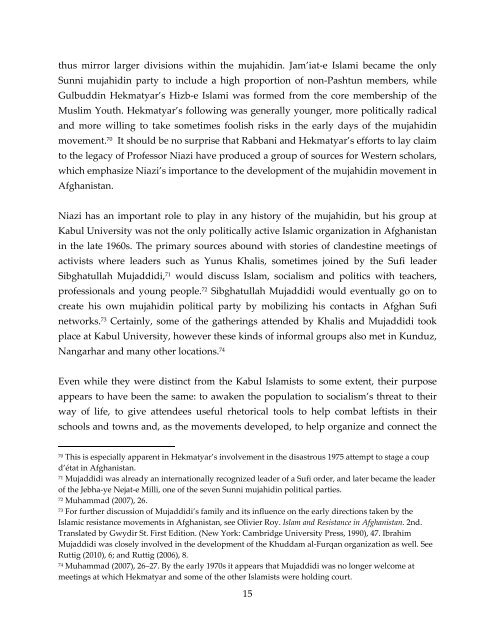Usama bin Ladin’s “Father Sheikh”:
Usama bin Ladin’s “Father Sheikh”:
Usama bin Ladin’s “Father Sheikh”:
You also want an ePaper? Increase the reach of your titles
YUMPU automatically turns print PDFs into web optimized ePapers that Google loves.
thus mirror larger divisions within the mujahidin. Jam’iat‐e Islami became the only<br />
Sunni mujahidin party to include a high proportion of non‐Pashtun members, while<br />
Gulbuddin Hekmatyar’s Hizb‐e Islami was formed from the core membership of the<br />
Muslim Youth. Hekmatyar’s following was generally younger, more politically radical<br />
and more willing to take sometimes foolish risks in the early days of the mujahidin<br />
movement. 70 It should be no surprise that Rabbani and Hekmatyar’s efforts to lay claim<br />
to the legacy of Professor Niazi have produced a group of sources for Western scholars,<br />
which emphasize Niazi’s importance to the development of the mujahidin movement in<br />
Afghanistan.<br />
Niazi has an important role to play in any history of the mujahidin, but his group at<br />
Kabul University was not the only politically active Islamic organization in Afghanistan<br />
in the late 1960s. The primary sources abound with stories of clandestine meetings of<br />
activists where leaders such as Yunus Khalis, sometimes joined by the Sufi leader<br />
Sibghatullah Mujaddidi, 71 would discuss Islam, socialism and politics with teachers,<br />
professionals and young people. 72 Sibghatullah Mujaddidi would eventually go on to<br />
create his own mujahidin political party by mobilizing his contacts in Afghan Sufi<br />
networks. 73 Certainly, some of the gatherings attended by Khalis and Mujaddidi took<br />
place at Kabul University, however these kinds of informal groups also met in Kunduz,<br />
Nangarhar and many other locations. 74<br />
Even while they were distinct from the Kabul Islamists to some extent, their purpose<br />
appears to have been the same: to awaken the population to socialism’s threat to their<br />
way of life, to give attendees useful rhetorical tools to help combat leftists in their<br />
schools and towns and, as the movements developed, to help organize and connect the<br />
70 This is especially apparent in Hekmatyar’s involvement in the disastrous 1975 attempt to stage a coup<br />
d’état in Afghanistan.<br />
71 Mujaddidi was already an internationally recognized leader of a Sufi order, and later became the leader<br />
of the Jebha‐ye Nejat‐e Milli, one of the seven Sunni mujahidin political parties.<br />
72 Muhammad (2007), 26.<br />
73 For further discussion of Mujaddidi’s family and its influence on the early directions taken by the<br />
Islamic resistance movements in Afghanistan, see Olivier Roy. Islam and Resistance in Afghanistan. 2nd.<br />
Translated by Gwydir St. First Edition. (New York: Cambridge University Press, 1990), 47. Ibrahim<br />
Mujaddidi was closely involved in the development of the Khuddam al‐Furqan organization as well. See<br />
Ruttig (2010), 6; and Ruttig (2006), 8.<br />
74 Muhammad (2007), 26–27. By the early 1970s it appears that Mujaddidi was no longer welcome at<br />
meetings at which Hekmatyar and some of the other Islamists were holding court.<br />
15


